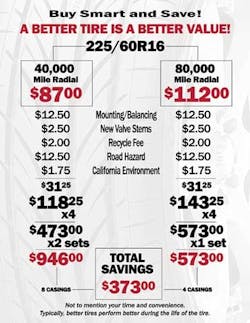In last month’s article, the topic was Michelin tires, Bayer aspirin and Fiji water: How are these manufacturers able to charge a premium price for their products when other products of similar quality and benefits are available at substantially less money?
The answers vary, of course, but the “perception of value” is key to “marketing for margin.”
It’s hard to argue with success — having customers whose experience with a product meets or exceeds their expectations. If Bayer aspirin has been relieving your back pain for years, why would you switch to a “no-name” brand for $4 less? Most of us have had the experience of a consumer standing at the sales counter requesting a replacement set of Michelins because they received over 80,000 miles on their original set. Why “risk” more back pain or fewer miles on some other brand?
Michelin and Bayer have earned their reputations through quality products, margin-driven marketing, and decades upon decades of satisfied customers. Every business must make a reasonable margin to stay in business, and to stay in business, a business must offer value, real value!
“Webster’s Dictionary” states the definition of “value” is the worth of a thing in money or goods at a certain time; the market price; a fair price; the quality of a thing according to which it is thought of as being more or less valuable, useful or desirable.
Because my clients are a combination of tire retailers and distributors, and because I hear a wide variety of comments and concerns every day, I feel I have a “feel” for the trends and what I might call the “emotional buzz” in the industry.
I’m sensing what I’m going to call a “heavy weariness,” a weariness beyond the normal daily grind, and it stems from two distinct and unique trends that we’ve not experienced in recent decades. Usually, when business is down or growth is minimal, tire prices decline. This is certainly not the cause today with frequent price increases that are sticking.
Secondly, the economy has been struggling and continues to struggle. Unemployment is high, and wages are not keeping pace with inflation. This current combination of events/trends is putting pressure on distributors, retailers and consumers. I have witnessed several irate customers who had purchased two particular tires months earlier and now felt they were being overcharged for the identical additional two tires. While speaking with an “informed, skilled and professional” management employee at a respected distributor, he blurted out in frustration, “Where’s the value of value? Everything seems to be price, price, price!” He’s feeling the pressure from the retailer, who’s feeling the pressure from the consumer. Manufacturers have been feeling the pressure from raw materials, shipping costs, emerging markets, etc.
My personal belief is that water seeks its own level, and products find their value in the marketplace. Tires have been undervalued for decades, and there is a shift by worldwide producers of tires to stabilize reasonable operating margins and develop products that consumers and governments demand. We are in a new reality as vehicle and rubber manufacturers try to squeeze every mpg out of every vehicle, and governments continue to raise CAFE standards as tires and proper tire fitments have, and will continue to become, substantially more complex and sophisticated.
Although tire manufacturers continue to attempt to communicate the additional value of their products to the variety of channels of distribution, the message has not really hit home yet.
I totally agree with my friend in the industry, “Where’s the value of value?” I believe that tires are worth the money, the current market price. What is needed is some hard-core selling, some real, hard-core value presentation.
Yes, customers want a good price; surveys show they also want a good tire. All the surveys show that customers want value. Most customers don’t/can’t really understand the value unless it’s explained in terms that make sense, in ways they can understand. The gap or difference between the price of a 40,000-mile tire and an 80,000-mile tire is not as wide as it once was, and with all the additional fees and add-on charges, the gap gets smaller.
Consider the added value represented in this comparison (see chart) which represents real value to a customer: Better tires are a better deal.
Wayne Williams is president of ExSell Marketing Inc., a “counter intelligence” firm based in La Habra, Calif. He can be reached at [email protected].

